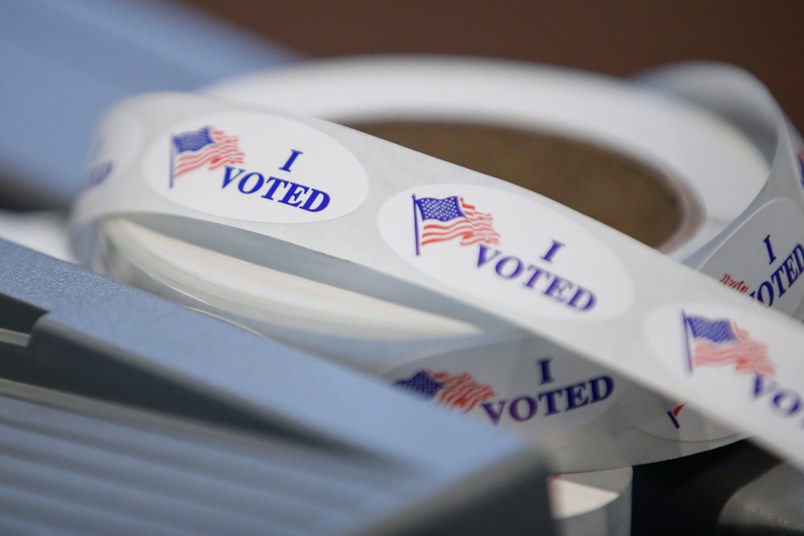State election officials signaled during an interview on MSNBC’s “Meet the Press” on Sunday that they expect election results in November to come in slower than usual as more states expand access to mail-in voting in light of the COVID-19 pandemic.
Election officials in Michigan, Ohio and North Carolina said that their respective states are taking measures to address an anticipated surge of absentee ballots ahead of the November election, despite President Trump’s baseless claims that vote-by-mail leads to voter fraud.
Here’s how they weighed in:
Michigan Secretary of State Jocelyn Benson
When MSNBC’s Chuck Todd asked whether Michigan should expect election results to come in closer to Thanksgiving — given how the state can’t start processing until Election Day and that it took a long time for results to be finalized during primary season — Benson refuted the notion, but conceded that “we should be prepared for this to be closer to an Election Week, as opposed to an Election Day.”
“I mean, the bottom line is we are not going to have the full results and a counting of all of our ballots on Election Night. We already know that,” Benson said. “We’ve asked the legislature to make changes to the law to give us more ability to be prepared and count those ballots more efficiently. They have not acted for reasons that I don’t fully, completely understand.”
Benson said that tabulators are being increased in order to more efficiently and securely count ballots.
Benson added that she’s “laser-focused on accuracy.”
“And if it takes a few extra days to ensure we have a full and accurate counting of the results of every race, that’s what it’s going to take,” Benson said. “And we’re going to be transparent throughout that whole process to make sure every citizen knows exactly where we are in the counting process and how many more ballots we have to get through.”
Ohio Secretary of State Frank LaRose
After saying his top concern is recruiting poll workers for Election Day and that he’s disappointed by the state’s legislature for not acting on resources to provide postage-paid absentee ballots to every registered voter who requests one, LaRose said that he is certain that the Electoral College will meet on Dec.14, despite Sen. Marco Rubio’s (R-FL) bill that would change the day the electors meet from to Jan. 2.
However, LaRose acknowledged that the expected increase in absentee voting this year prompted Ohio to make efforts to clearly communicate to voters that Election Night totals aren’t final results.
“We know that over the next ten days, as long as those ballots were legally cast, they can continue to be received at our Board of Elections. That’s our law here in Ohio,” LaRose said. “And so we’re making it clear that the numbers that you hear on Election Night are never the final result, and that’s going to be even more so the case this year as we rely on more and more absentee balloting.”
LaRose said that Ohio is changing its Election Night reporting on its website by being transparent that “there still may be tens or hundreds of thousands of outstanding absentee ballots.”
“We expect those to come back in. Whether it’s one of my former military teammates who’s serving overseas, or maybe an Ohioan that just procrastinated and waited till the last minute, as long as those ballots are legally cast, they deserve to be counted,” LaRose said. “And so again, Election Night, yeah, we’ll give a snapshot of those results. But the final tabulation is what really matters.”
Karen Brinson Bell, executive director of the North Carolina State Board of Elections
Although she’s not particularly worried about North Carolina dealing with a surge in absentee ballots, Brinson Bell acknowledged that the state is “uniquely positioned” due to sending out nearly 600,000 absentee-by-mail ballots on Friday.
“We are ahead of the game in sending out those ballots,” Brinson Bell said. “That’s more time for voters to return them.”
Brinson Bell added that North Carolina has had the ability to process absentee-by-mail ballots ahead of Election Day.
“We also tabulate on Election Day the results from our one-stop early voting, which we think will be about 50 percent of the ballots cast. We’ll have probably had 30 percent, 40 percent of the ballots cast absentee-by-mail,” Brinson Bell said. “So even by the close of polls on Election Night, we may be reporting as much as 80% of our voter turnout and how they’ve chosen before — at the time that the polls close.”







Trump’s insistence that the winner be ‘announced’ on the evening of the 3rd - is his way of discounting the mail in votes.
Expect the vote in person tallies to lean his way. He’ll do anything he can to halt the count. Instead of a “Brooks Brothers Riot” - we’ll see scores of “Cammo Riots” as Maga-heads with AR 15’s storm registrar’s offices to ‘stop the fraud’.
That IS their plan. Win the ‘airwaves’ on election night - then halt/muddle/litigate the mail in.
Very good that this is being publicized early. The public and the media need to be educated. The best way to stop–or, more likely, defang–a bogus Trump victory claim on November 3rd is to set in stone that the results will not be finalized until the end of the week.
Great to see that tRumps actions are allowing us to prepare for most election stunts ahead ahead of time and war gaming the possibilities.
https://www.washingtonpost.com/outlook/2020/09/03/trump-stay-in-office/?arc404=true
" Secretaries Of States Expect Delayed Results In The November Election"
Surprising who ?
And look who’s talking BS.The one who had his weekday news slot snatched away.
That sounds like full-on election tampering worthy of felony counts against ALL involved. . . including Trump.